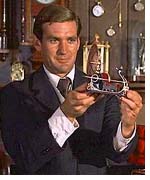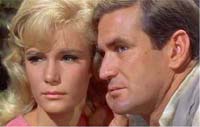"The Time Machine" (1960)
Rod Taylor plays George (H. G. Wells) in this science fiction classic,
his first full-fledged starring role.
And all the first-time leading man had to do was make us believe in time
travel, deliver poignant social commentary, fight off fearsome mutant creatures,
and convey the emotions of a longtime friendship as well as a new romance.
Of course, Taylor succeeds as director George Pal delivers a film with
Oscar-winning special effects wrapped up in a story with deliberate pacing
and fine performances.
Taylor faces a challenge from the start: He must burst upon the scene
-- a very civilized Victorian-era dining room -- bearing the horrors and
wonders he's seen as he's traversed the centuries. And despite his bloodied,
battered, wearied state, Taylor must make it clear he's no mad scientist.
 Through flashback, the tale starts on a small scale, literally, as George
demonstrates a miniature version of the time machine. Among friends, he
calmly poses the possibility of moving through time as easily as we move
through space. But his friends scoff, and tell him he should put his talents
toward helping the war effort. Through flashback, the tale starts on a small scale, literally, as George
demonstrates a miniature version of the time machine. Among friends, he
calmly poses the possibility of moving through time as easily as we move
through space. But his friends scoff, and tell him he should put his talents
toward helping the war effort.
One friend, Filby (Alan Young) comes closest to believing -- actually
fearing -- that the machine really could work, and he stays behind to gently
caution George. But determined to seek wisdom from the people of the future,
George sets off to test his time machine -- on a large scale.
Maintaining the pacing that roots the story in the plausible and familiar,
Pal doesn't have George leap into the machine and race off to the distant
future. No, he advances hesitantly at first. We're given visual cues of
the passing of time -- a candle burning quickly, the sun racing across the
sky. And we get cues that the machine does not pass through space -- sharing
George's amusement as he watches the fashions change on the mannequin in
the store window across the street.
Emboldened, George jumps ahead in greater increments but stopping at
familiar timeposts -- World Wars I and II -- where we encounter familiar
faces and reminders that the place is the same. Nuclear war devastates everything
during a stop in 1966, and George finally races ahead.
When he reaches the year 802,701, London seems to have become a Garden
of Eden. We're alone with George now, and we follow Taylor's reactions as
the actor ranges through an arc of emotion. We feel George's wonder and
amazement while exploring the exotic landscape, then his despair when he
senses his isolation. His delight upon sighting the carefree Eloi gives
way to anger as he leaps into action to rescue Weena (Yvette Mimieux) from
drowning. Ultimately, he is perplexed at the apathy of Weena and her people.
Back at a dinner table -- surrounded by Eloi rather than his old friends
-- George at last gets his chance to satisfy his curiosity. He peppers his
companions with questions. But their minds are empty and their books have
turned to dust. In a rage, he vows to return to his time to "die among
men."
His getaway thwarted because the time machine has been dragged behind
sturdy steel doors, George nevertheless finds a spark of hope when Weena
risks her own safety to warn him of the danger in the dark. Director Pal
then begins a familiar pattern, showing how the small-scale flicker of a
match scares off a marauding Morlock.
Later, when George finally plunges into the Morlocks' subterranean lair
to rescue Weena and the other Eloi, the small sparks ignite: George uses
fire to ward off the Morlocks, and an Eloi strikes out to save him from
strangulation. With Russell Garcia's rich score soaring, George leads the
Eloi to safety and they destroy the Morlocks.
Having already demonstrated a scientist's intellect and a hero's physical
strength, a brief romantic interlude presents another layer to Taylor's
performance. Alas, the smoldering anticipation of a first kiss with Weena
is interrupted as the Eloi discover the doors have opened, freeing the time
machine. Another hesitation -- and Weena is blocked from joining George
on a journey back to "his time." With one last run-in with the
Morlocks, George races back to the safety of 1900, his friends and his home.
After relating this tale and facing more skepticism, we sense George's
decision. A simple, moving "good-bye" to his loyal friend Filby
speaks volumes.
Dragging the time machine back to his laboratory -- so that it's on the
safe side of the doors in 802,701 -- George takes off again, to rejoin Weena
and the Eloi.
Taylor's performance and story's structure ultimately leave us with the
confidence that George can kindle all those sparks -- of love, humanity,
strength and curiosity -- in the Eloi. And the film leaves us with a question:
Which three books did he take along to begin building a new civilization?
|
|


Click for Gallery

|
FILBY |
|
George's friendship with Filby (Alan Young) is a key constant
in "The Time Machine."
During George's first stop through time, he learns -- from
Filby's son -- that Filby has been killed in World War I. But George also
finds out that in the 16 years that have elapsed, Filby maintained George's
home, certain that his friend would someday return.
When George eventually does return from his time travels,
knowledge of such loyalty shades the touching farewell he delivers to his
friend (above). |
|
NEAR MISS |
|
I turned the part down to begin with. Then George Pal,
the producer-director, called me and said he wasn't making a "science
fiction picture." He was making 'an H.G. Wells picture."
He said,
"I've never directed before. There are areas you can help me and areas
where I can be of help to you." ... It did give me an opportunity to
work closely with the director, rather than just coming to work and going
home.
-- Rod Taylor,
TV Radio Mirror,
January 1961 |
|
|
When it came to casting the Time Traveler, director George Pal had considered
actors Paul Scofield, Michael Rennie and James Mason, but he eventually
turned to Rod Taylor's "more youthful appeal," according to a
Starlog magazine article from July 1986.
Here's more from the article, leading off with Rod's comments about the
director of "The Time Machine":
"George Pal was a genius. He was a lovely,
warm-hearted man. I thought of him as a funny little elf. He was surrounded
by tiny puppets and toys, which he brought to life in his movies."
A childhood fan of H.G. Wells' work, Taylor was extremely
enthusiastic about his first starring role. ... "[Pal] had a marvelous
talent for illustration, and I was fascinated with his pre-production drawings.
He knew that I was an artist, so we got along beautifully. We worked in
close partnership, and I even helped him find the female lead....
"There was a lot of trouble casting Weena.
I suggested that I test with different girls. My first choice was
Shirley Knight. Yvette and I have since become dear friends, but at that
time, I thought she was kind of a strange little hippie child. I was afraid
she would be hard to work with.
"I knew when I did her screen test that Yvette couldn't
act at all. But she had a sulky quality with George believed was right.
The innocence she projected as part of her character was actually innate
in her own personality. I often wondered if she was even listening to me
when we shot our scenes.
"Eventually, though, Yvette became a very good actress.
She was a delight to work with when we made 'Dark
of the Sun' in 1968. She is actually a much better actress than she
is given credit for being."
Paying tribute to the visionary British writer, Pal subtly
indicated that the Time Traveler was actually Wells himself by attaching
an engraved plate on the time machine, which read: "Manufactured by
H.G. Wells."
"I didn't attempt to think what Wells may have really
been like," Taylor comments. "I played my version of what
a magnificent guy he must have been. Why couldn't he have been strong,
romantic and athletic, as well as a brilliant scientist? George was very
happy with my conception. I think it was the ballsiness of Wells,
as I played him, combined with being highly intellectual, which sold the
character."
... Surprised by the unexpected critical and commercial
success of "The Time Machine," Taylor and Pal intended to team
up again. ... [But] disappointment and frustration continually plagued
Pal during his final years, even sabotaging his long-planned "Time
Machine" sequel, in which Taylor and Yvette Mimieux would have reprised
their original roles.
"George wasn't quite sure what the plot was going
to be," Taylor reveals. "He had some marvelous ideas, but he
kept changing the concept. He told me about five different storylines,
but I never read any completely finalized script."
The Web site for Turner Classic Movies does mention one concept for a
"Time Machine" sequel that George Pal described in a 1982 interview:
"We would have loved to make a sequel having the Time
Traveler go back in time, or -- there was a great sequence which (was cut), it
just didn't fit into our plot -- to go back to the same place and then go
further into the future when the crabs took over.
"It was very beautiful -- I can just see Rod Taylor
and Yvette Mimieux, just the two of them...go in there where the crabs are and
the ocean is flat and doesn't move anymore and the sun is hot all the time. I
think we could have developed a very interesting story of the loneliness of
these two people."
(The scene with the crabs comes from Chapter
11 of Wells' story.)
|